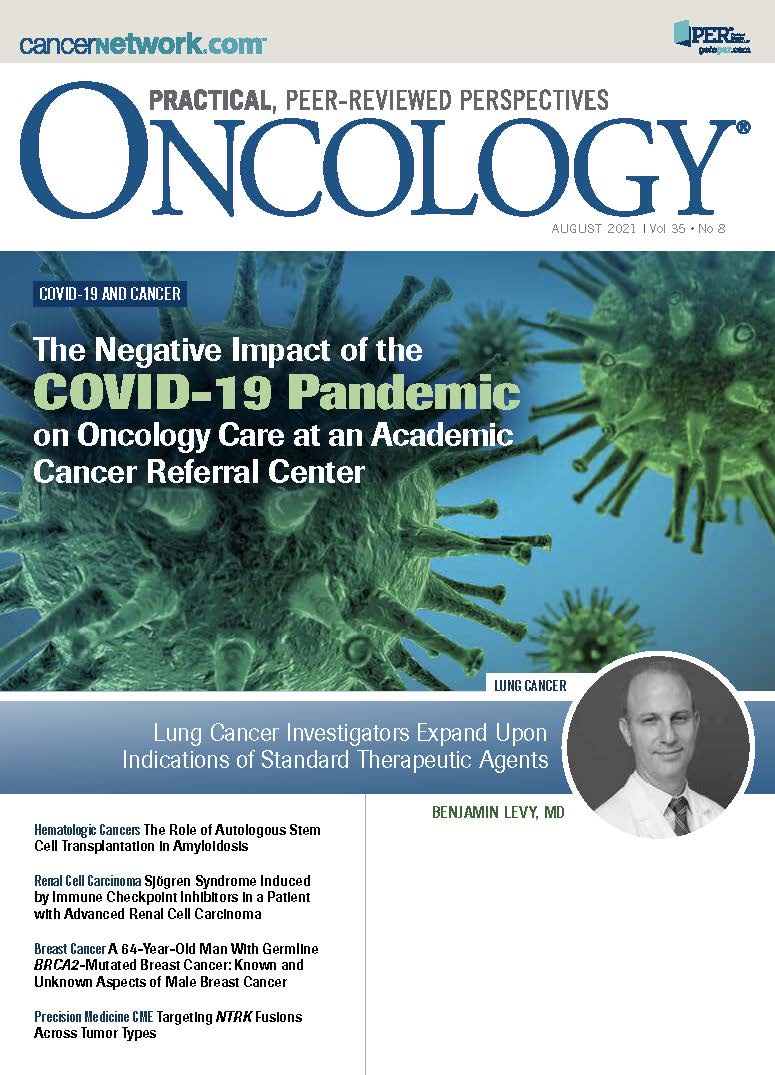Evolving Role of Autologous Stem Cell Transplantation for Light Chain Amyloidosis in the Modern Era
Muhamed Baljevic, MD, considers the role of autologous stem cell transplantation for light chain amyloidosis in a peer perspective accompanying an article by Iuliana Vaxman, MD, and Angela Dispenzieri, MD.
Muhamed Baljevic, MD, is from the Department of Internal Medicine, University of Nebraska Medical in Omaha, NE.

Compared with patients with multiple myeloma (MM), those with light chain (AL) amyloidosis tend to harbor nonproliferative, chemotherapy-sensitive plasma cell clones with lower frequency of high-risk genetic aberrations, leading to lower tumor burdens overall. Therefore, autologous stem cell transplantation (ASCT) in AL amyloidosis tends to yield more durable long-term outcomes with respect to progression-free survival and overall survival (OS), especially following the period of induction therapy. However, due to delayed diagnosis and ongoing deposition of insoluble amyloid fibrils leading to end-organ damage that is commonly irreparable in AL amyloidosis, only roughly a quarter of patients are adequate candidates for ASCT.
It must also be highlighted that accurate subtyping in all patients with amyloidosis remains the key initial step, irrespective of the presence of a plasma cell dyscrasia and especially despite it, since crucially, monoclonal gammopathy plus positive amyloid biopsy does not always equal AL amyloidosis, due to significant co-occurrence with wild-type transthyretin amyloidosis.1 Authors of this comprehensive review further list the essential components that dictate achievement of best long-term outcomes for AL amyloidosis, which include the optimal utility and timing of ASCT which was first reported nearly 3 decades ago for this rare hematologic malignancy.2
Previous limited availability of effective therapies for AL amyloidosis meant that rates of stringent complete response (CR) with full normalization of serum free light chains were low. In the modern era, though, it can be argued that therapy goal is too modest—considering the very low clonal plasma cell burden at diagnosis, the goal should perhaps be a minimal residual disease (MRD)-negative state. Rather remarkably, the first therapy for the treatment of AL amyloidosis to receive US FDA approval garnered it only quite recently.3 As such, the use of ASCT as a treatment modality in a subset of patients with AL amyloidosis who were deemed fit, and in whom the therapy would likely be safe, remained an important option.
Nevertheless, the therapeutic arsenal in AL amyloidosis expanded greatly off label over the years, with the natural adoption of antiplasma cell treatments from the MM world. In those patients who avoid early mortality, modern therapies can deliver high-quality responses: very good partial response (VGPR) or better in nearly two-thirds of patients.4,5 These agents include those in the earliest classes of drugs utilized, such as alkylators and corticosteroids, as well as more novel agents, such as proteasome inhibitors and immunomodulatory drugs, all of which have transformatively more than tripled OS in AL amyloidosis.4,6
The latest agent to successfully join the treatment paradigm in this disease is the anti-CD38–targeting monoclonal antibody (mAb) daratumumab (Darzelex); it notably is not associated with the toxicities to organ beds, such as the cardiac or renal, where the disease process itself already causes significant compromise. In the safety run-in cohort of the phase 3 ANDROMEDA study (NCT03201965)—which studied daratumumab plus bortezomib, cyclophosphamide, and dexamethasone (CyBorD) vs CyBorD alone in patients with newly diagnosed AL amyloidosis—investigators reported an overall hematologic response rate of 96% and a VGPR or better in 82% of patients (54% CR).7 The advantage in achieving hematologic CR is what ultimately led to an accelerated inaugural FDA approval for daratumumab in this combination for AL amyloidosis; hematologic CRs were achieved more than twice as often than with bortezomib-based regimens.5 In the authors’ recently published full report of ANDROMEDA, after a median follow-up of 11.4 months, hematologic CR was significantly higher with the daratumumab quadruplet than with CyBorD alone (53.3% vs 18.1%, respectively). Survival free from major organ deterioration, hematologic progression or death significantly favored quadruplet arm as well (HR, 0.58; 95% CI, 0.36-0.93; P = .02).8 In this trial, 13 patients (6.7%) in the daratumumab group and 20 (10.6%) in the control group received subsequent ASCT. Results for OS were too immature to report. Lastly, daratumumab was delivered subcutaneously with negligible volume of administration; both features
contribute favorably to lower systemic administration-related reactions, which can be common in an often frail and sensitive AL amyloidosis population.
Based on these recent findings, the role and the optimal timing (early vs delayed) of ASCT in AL amyloidosis is an area of active discourse. This is particularly true for sicker patients who may not otherwise be good candidates for full-intensity melphalan conditioning (200 mg/m2), which would be expected to impact the disease-related outcomes.6 Beyond the organ dysfunction and mortality risk that AL amyloidosis imparts, transplant-related mortality—although significantly reduced through the refinement of ASCT selection criteria over the years—remains among the pivotal factors influencing safe applicability of ASCT in this disease, particularly in centers with limited, low-volume experience.9 A fundamental question to consider is the role of ASCT in patients who have already attained very deep responses to induction therapy, such as those with CR or MRD negative status, and whether risking any ASCT-related harms is justifiable in those individuals. Limited retrospective data, as pointed by the authors of the review, suggest that hematologic CR and lack of cardiac involvement—not ASCT—were associated with treatment-free survival.10
The treatment landscape of AL amyloidosis is likely to continue changing, particularly with ongoing incorporation of molecularly targeted therapies such as venetoclax (Venclexta)11 or various amyloid-directed therapies in development, such as the mAb 11-1F4.12 Prospective trials that employ randomization and are based on deep induction responses to modern standard-of-care therapies are needed to help clarify the long-term role of ASCT in this disease. Until then, we believe that patients who are well selected for safety and additional efficacy should continue deriving benefit from ASCT, which indeed remains an important therapeutic tool in the treatment of this lethal form of systemic amyloidosis.
Author declares the following conflicts of interest:
Internal review committee (member): Karyopharm
Consultancy: Bristol Myers Squibb/Celgene
Advisory boards: Bristol Myers Squibb/Celgene, Oncopeptides, Janssen Research, Karyopharm
Research support: Amgen, Exelixis
References
1. Sidiqi MH, Dasari S, McPhail ED, et al. Monoclonal gammopathy plus positive amyloid biopsy does not always equal AL amyloidosis. Am J Hematol. 2019;94(5):E141-E143. doi:10.1002/ajh.25440
2. Comenzo RL, Vosburgh E, Simms RW, et al. Dose-intensive melphalan with blood stem cell support for the treatment of AL amyloidosis: one-year follow-up in five patients. Blood.1996;88(7):2801-2806.
3. DARZALEX FASPRO® Prescribing Information. Horsham, PA: Janssen Biotech, Inc.
4. Muchtar E, Gertz MA, Kumar SK, et al. Improved outcomes for newly diagnosed AL amyloidosis between 2000 and 2014: cracking the glass ceiling of early death. Blood. 2017;129(15):2111-2119.
5. Manwani R, Cohen O, Sharpley F, et al. A prospective observational study of 915 patients with systemic AL amyloidosis treated with upfront bortezomib. Blood. 2019;134(25):2271-2280. doi:10.1182/blood-2016-11-751628
6. D’Souza A, Dispenzieri A, Wirk B, et al. Improved Outcomes After Autologous Hematopoietic Cell Transplantation for Light Chain Amyloidosis: A Center for International Blood and Marrow Transplant Research Study. J Clin Oncol. 2015;33(32):3741-3749. doi:10.1200/JCO.2015.62.4015
7. Palladini G, Kastritis E, Maurer MS, et al. Daratumumab plus CyBorD for patients with newly diagnosed AL amyloidosis: safety run-in results of ANDROMEDA. Blood. 2020;136(1):71-80. doi:10.1182/blood.2019004460
8. Kastritis E, Palladini G, Minnema MC, et al. Daratumumab-Based Treatment for Immunoglobulin Light-Chain Amyloidosis. N Engl J Med. 2021;385(1):46-58. doi:10.1056/NEJMoa2028631
9. Kumar S, Dispenzieri A, Gertz MA. High-dose melphalan versus melphalan plus dexamethasone for AL amyloidosis. N Engl J Med. 2008;358(1):91; author reply 92-93.
10. Muchtar E, Gertz MA, Lacy MQ, et al. Ten-year survivors in AL amyloidosis: characteristics and treatment pattern. Br J Haematol. 2019;187(5):588-594. doi:10.1111/bjh.16096
11. Premkumar VJ, Lentzsch S, Pan S, et al. Venetoclax induces deep hematologic remissions in t(11;14) relapsed/refractory AL amyloidosis. Blood Cancer J. 2021;11(1):10. doi:10.1038/s41408-020-00397-w
12. Edwards CV, Bhutani D, Mapara M, et al. One year follow up analysis of the phase 1a/b study of chimeric fibril-reactive monoclonal antibody 11-1F4 in patients with AL amyloidosis. Amyloid. 2019;26(suppl 1):115-116. doi:10.1080/13506129.2019.1584892

Navigating AE Management for Cellular Therapy Across Hematologic Cancers
A panel of clinical pharmacists discussed strategies for mitigating toxicities across different multiple myeloma, lymphoma, and leukemia populations.